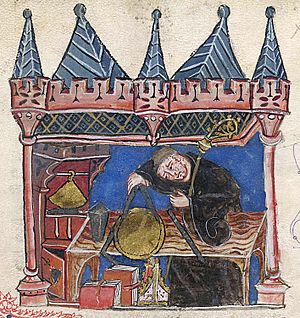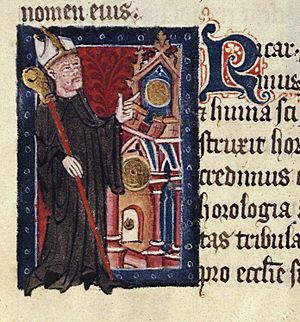Richard of Wallingford facts for kids
Quick facts for kids
Richard of Wallingford
|
|
|---|---|

Richard of Wallingford measuring with a pair of compasses in this 14th-century miniature.
|
|
| Born | 1292 Wallingford, England
|
| Died | 1336 |
| Occupation | Astronomer, horologist, cleric, mathematician, astrologer |
Richard of Wallingford (born in 1292, died in 1336) was a very smart English person. He was a mathematician (someone who studies numbers), an astronomer (someone who studies stars and planets), and a horologist (someone who designs clocks). He was also a cleric, which means he was a religious leader. Richard made big contributions to how we understand the sky and how we build clocks. He did all this while he was the abbot (the head monk) of St Albans Abbey in Hertfordshire, England.
Contents
Richard's Early Life and Education
Richard was born in 1292 in Wallingford, England. His father was a blacksmith. When Richard became an orphan (meaning both his parents had died), he was taken in by William de Kirkeby. William was the Prior (a leader) of Wallingford Priory. A priory is a type of small monastery.
Wallingford Priory was connected to the larger St Albans Abbey. Richard first studied at Oxford University for six years. After that, he became a monk at St Albans. He then went back to Oxford and studied for nine more years. In 1327, he became the abbot of St Albans. This meant he was the main leader of the abbey.
Designing an Amazing Astronomical Clock
Richard is most famous for an amazing astronomical clock he designed. He created the plans for this clock while he was the abbot. He wrote down all the details in a book called Tractatus Horologii Astronomici (which means "Treatise on the Astronomical Clock").
The clock was finished about 20 years after Richard died. It was built by a person named William of Walsham. Sadly, this incredible clock was destroyed. This happened during the time of King Henry VIII. During the English Reformation, many monasteries like St Albans Abbey were closed down.
Richard's clock was almost certainly the most complex clock in Britain at that time. It was also one of the most advanced clocks anywhere in the world. Another very complex clock from the 1300s was the astrarium by Giovanni Dondi dell'Orologio.
Richard's clock could tell the time in different ways. It also showed the phases of the moon. It could even show the positions of the moon's nodes. These nodes are important for predicting tides. His clock could even show the height of the tide at London Bridge!
Recreating Richard's Clock
Even though the original clock was destroyed, people have tried to rebuild it. They used the old writings from the 1300s to figure out how it worked.
One famous recreation was built by Haward Horological. For many years, it was shown at the Time Museum in Illinois. Now, you can see it at the Halim Time and Glass Museum in Evanston, Illinois.
Other versions of the clock have also been built. One is at the Wallingford Museum. Another was built in 1988 and is at St Albans Cathedral. A different one was made by Don Unwin for the Whipple Museum of the History of Science in Cambridge.
Richard became very sick during his life. People at the time thought he had leprosy. He may have caught this illness when he traveled to Avignon. He went there to get his position as abbot confirmed by the Pope. Richard died in St Albans in 1336.
Richard's Studies in Astronomy and Mathematics
Richard was also a brilliant inventor of calculation tools. He designed and built several devices.
He created a torquetum, which was an old tool used to measure the positions of stars and planets. He also made something called the Rectangulus.
Another important device he made was an equatorium. He called this one Albion. The Albion could be used for many astronomical calculations. It could figure out the longitudes (positions) of the moon, sun, and planets. It could also predict eclipses. What was special about Albion is that it could do all this without needing many tables of numbers to copy out. Richard described this device in his book called Tractatus Albionis.
Richard also wrote other books. These books were about trigonometry (a type of math), how to find positions in the sky, and astrology. He also wrote several religious works.
See also


